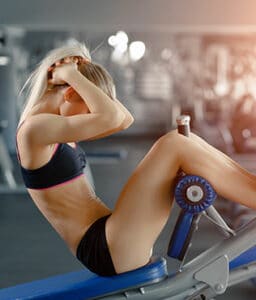Functional workouts
The term “Functional Training” has been popular in the fitness world for decades and increasingly appears in gym ads, fitness magazines and social media videos.
Unfortunately, when a term becomes trendy in the weight loss or fitness industry – it tends to be overused.
The keto diet, HIIT workouts and functional workouts are good examples.
In this article, we’ll look at what Functional Training is and how it differs from other types of training.
What is functional training?
If you ask five fitness experts to define what functional training is – you will most likely get five different definitions. The term “functional training” is one of the most misunderstood in the industry. It was first used in sports medicine to describe the rehabilitation of athletes – improving and/or developing the skills needed for activities of daily living.
Specifically, functional training focuses on movements that help us function better in everyday life, such as:
- Standing up from a lying or sitting position.
- Lift and move heavy objects.
- Lift a child or pet, etc.
In fact, functional training has been around for as long as humans have existed. To survive, ancient humans hunted and gathered plants. If they couldn’t run fast enough to hunt or weren’t strong enough to use weapons, they just couldn’t survive. For thousands of years, our ancestors lived and evolved with one rule – the strongest survives.
Today, our lives are different, and our bodies are becoming more and more frail. We often injure them because we simply do not know how to control our bodies, for example – how to lift heavy objects properly.
We are made to push, pull, bend, stoop, squat, step up, twist, etc.
The purpose of these movements is to train our muscles and keep them working – the way they were designed to work. Functional training usually uses compound/combined exercises, meaning that more than one joint is flexed, and several muscle groups are involved in the movement.
Many of us do not use many of these movement patterns in everyday life, especially if our life is spent mainly at a desk.
That’s why.
We must train these movements in a targeted way because we lose skills we do not use.
Back and lower back pain, sprains, ligament and tendon tears are only some possible problems.
Modern functional fitness is based on rehabilitation and therapy techniques. Physiotherapists, occupational therapists and chiropractors often use Functional Fitness to treat patients with movement disorders – Functional exercises are “prescribed” to treat movement disorders resulting from accidents, injuries, operations, etc., to help the patients correct movement deficiencies and lead a more fulfilling life.
Functional training is always individualised – the training programme is designed according to a careful assessment of each person’s physical abilities and goals.
Benefits of functional training
Functional exercise teaches our body to function as a whole rather than training/improving specific body parts. This whole-body strengthening has the following benefits:
- Functional training trains the same muscle movements that we use in everyday life. By improving overall body function, increasing muscle strength and endurance, improving balance and flexibility and developing muscle and body stability, our quality of life improves – less stress, better well-being, we can climb to the nth floor without gasping and move with more ease and confidence.
- Functional Exercises can help maintain and improve balance and coordination as they promote coordinated movements of different body parts. This is particularly useful for older people to prevent falls and related injuries. Functional training can also help to regain balance and improve coordination when recovering from injuries.
- By perfecting everyday movements, we can prevent injuries, for example – protecting the spine from moves that cause back pain, etc.
- Using functional exercises based on sport-specific movements allows people to improve their athletic performance. For example:
- Basketball players can practise jumping from side to side to improve their agility and speed on the court.
- Rowers can practice squats to train the same leg muscles they use in the boat.
- etc.
- The functional workouts can be more time efficient for general fitness and weight loss – a few shorter but more intense Full Body workouts can improve body composition, muscular strength, and endurance more quickly and burn more calories.
How does functional training differ from other types of workouts?
Many fitness activities include functional exercises. This is one of the reasons why it can sometimes be hard to distinguish Functional Training from other types of exercise.
The main difference is that Functional Training focuses on the harmonious development of the whole body, compared to other types of training with more specific/narrower goals (Strength Training to increase muscle mass, Cardio to increase cardiovascular endurance, etc.).
Here are the main differences between Functional Training and other popular workout methods:
- Functional vs Strength training:
- Functional workouts – focus on movements replicating real-life activities, incorporating exercises that combine multi-joint movements to improve overall functional fitness, balance and coordination.
But.
-
- Strength training – focuses primarily on increasing muscle strength and hypertrophy (muscle growth) by focusing on specific muscle groups.
- Functional Training vs CrossFit:
- Functional workouts – include a wide range of movements and exercises designed to improve everyday functional fitness. They may or may not be included in high-intensity workouts.
But.
-
- CrossFit is a high-intensity fitness program combining the elements of Functional Training, Weightlifting, Powerlifting, Gymnastics and Cardio.
- Functional Training and Group Classes:
- Functional workouts – can also be group workouts, but with an emphasis on functional movements and a variety of exercises tailored to the individual needs of the participants.
But.
-
- Group classes – usually include a variety of Functional, Strength, Cardio and other exercises.
- Functional Training vs Cardio:
- Functional workouts – include cardio exercises but focus on improving overall functional fitness, balance and muscle engagement during everyday movement.
But.
-
- Cardio workouts – primarily include exercises designed to improve cardiovascular endurance, such as running, cycling or swimming. Functional training may incorporate cardio exercises, but cardio training may not incorporate Functional exercises.
- Functional training vs. HIIT (High Intensity Interval Training):
- Functional workouts – may incorporate HIIT principles but focus on simultaneous multi-joint movements that mimic our everyday motions.
But.
-
- HIIT workouts – focus on short periods of intense exercise followed by short periods of rest. Although HIIT can be functional, it can also include exercises that work on specific muscle groups or joints only.
- Functional training vs bodybuilding:
- Functional workouts – the priority is functional movement and general functional fitness. Exercises are performed that engage several muscle groups and joints simultaneously. Aesthetic goals may be secondary.
But.
-
- Bodybuilding – focuses primarily on muscular hypertrophy and aesthetics by isolating and purposefully increasing specific muscle groups. Functional fitness is secondary.
In other words, functional training aims to prepare us for all aspects of life, not just to improve our appearance, train us to lift heavy weights or walk for hours on a treadmill at the gym.
For example, if you focus on strength exercises only, you might be able to lift a 300 kg barbell and squat with it a few times, but you will be out of breath if you quickly climb the stairs to the fifth floor.
How often should you do functional workouts?
As with any other type of training, your body needs time to rest and recover to achieve the desired results. The number of times you train per week depends on your goals and the intensity of your workouts, and as functional training involves the whole body, it is a good idea to take a day off between workouts.
To maintain the health of your muscles and bones, you need to train at least twice a week.
However, if your body recovers quickly (you feel a surge of energy every time you train), you can train up to 4 times a week.
How can I incorporate functional exercises into my workout?
Functional exercises can vary for different muscle groups and goals. Some of the most common Functional Exercises are:
- Push-ups.
- Walking lunges.
- Squats.
- Jump Squats.
- Jumping or Box Step up.
- Running sideways.
- Jumping rope.
- Movements performed while balancing on one leg.
If you like HIIT, group workouts or any other form of exercise, stick with it. Each of us may have specific goals that require specific exercises. For example, exercises that target only certain leg muscles can help runners increase their speed, etc.
But.
Try to include functional exercises in your workout routine.
This will help you not only with your fitness goals but also with increasing the range of movement of your body, improving your sense of balance, coordination, flexibility… – your overall fitness.
Key takeaways
Our bodies are designed for all muscles to work together and support each other to perform specific movements/tasks.
Therefore.
Functional training is a fantastic way to stay fit and healthy.
Functional exercises mostly use your body weight, so no extra equipment is needed in most cases, making them simple, safe and doable for almost anyone.
Include functional exercises in your training routine, but to get the most out of them – it’s best to have a certified trainer with at least ten years of experience design your training programme.
Eat balanced, exercise and stay healthy and full of life!
FUNCTIONAL TRAINING Fad or Here to Stay?
WHAT IS FUNCTIONAL/NEUROMOTOR FITNESS?
Effects of Functional Strength Training on Functional Movement and Balance in Middle-Aged Adults
FUNCTIONAL VS. STRENGTH TRAINING IN ADULTS: SPECIFIC NEEDS DEFINE THE BEST INTERVENTION
Effect of Functional Training on Physical Fitness Among Athletes
Effect of Functional Resistance Training on Muscular Fitness Outcomes in Young Adults
The Benefits of High Intensity Functional Training (HIFT) Fitness Programs for Military Personnel
MIDLIFE FUNCTIONAL FITNESS A Key to Successful Aging
Traditional and Functional Workouts – Are They Really That Different?

Help to maintain this site, create interesting articles and delicious low-calorie recipes!
Share this article
Follow me on Facebook
I recommend reading these articles as well

Why do I want to eat all the time?
If hunger does not leave you even after a fresh meal and you want to eat all day - it is possible that the body warns you about a health problem.

How To Develop Muscle Strength And Endurance
Have you been to the gym for a while but can't see the results? You may not challenge yourself enough.

Healthy and unhealthy food
How does ultra-processed food affect our health? Or, why is it better to cook by yourself and eat with family and friends?

Salt - healthy or unhealthy?
What is salt? What functions of our body do we need it for? What happens to us if we have too much or too little salt in our body?

